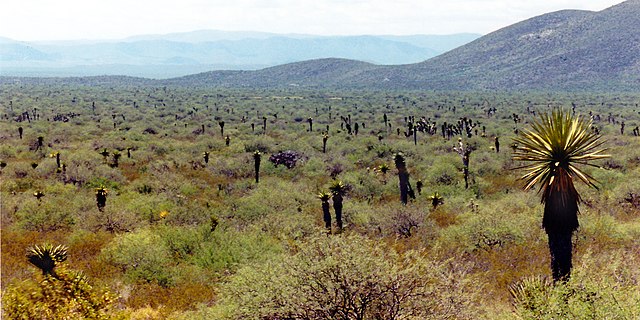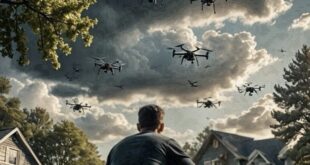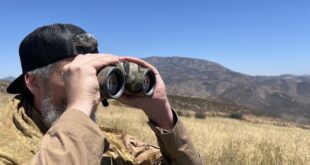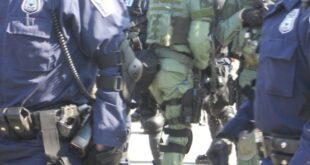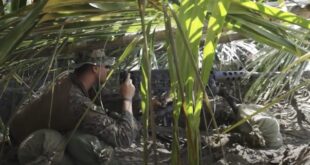by Heath Hansen
Pop! Pop!
Distant AK-47 fire pierces the night silence. I’ve been sitting in my spot on this mountain for a few hours when I hear the gunfire. Up until now, I had been plunged into the endless silence of a desert night in the Coronado National Forest. The sky above me bursts with more stars than you could ever see in the city. When you are this far away, nature is overpowering.
Pop!
I hear another gunshot. This time it’s closer. The scouts are communicating with their group, situated further south, that it’s time to move forward across the Mexican-American border.
I watch through the green hue of my night vision goggles, unable to see the group but knowing they are there. Unfortunately for the drug mules attempting to move product into the U.S., they are unaware Arizona Border Recon (AZBR) is on patrol at this section of the border, upholding their motto and conquering “One Hill at a Time.” For more than a decade, AZBR volunteers have assisted Border Patrol by sharing intelligence concerning the international border.
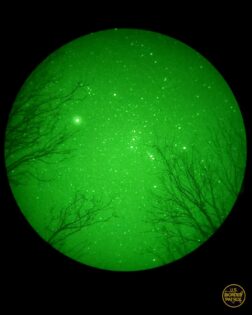
Recently, I trained with AZBR in these mountains and was invited back for an operation. Once in Southern Arizona, I stopped at Tim Foley’s house to get updated grids and a plan for the week. While there, the leader of AZBR updated me on the situation at the border and the threats to expect while patrolling the treacherous terrain.
READ MORE about Heath Hansen’s experiences on the U.S. southern border
I walked into his office, and he showed me recent footage he had caught while hiking in the area.
“Here, on the mountaintop, you can see three scouts, holding AK-47s,” he said. “They’re waiting for the group to move north.”
I see armed men, wearing camouflage, casually perched on a ridgeline. “I thought guns were illegal in Mexico,” I said to Tim, smirking. We look at each other and laugh.
“Yeah, me too,” he replies. Foley then tells me the base camp locations (our group is large so we will have two camps). We will be half a mile from the border. The next morning, we load the vehicles and head out.
The route is dusty, winding, and very rocky. My vehicle nearly bottoms out a few times before reaching base camp. Tall saguaro cacti dot the high mountains surrounding our tent area. In the distance, to the south, the wall that Trump built is visible. Some of the low spots of the wall have gaps where a hinge system was meant to be constructed. This system would allow water to flow freely, and at the same time prevent people from passing. When the Biden administration took over, it halted wall construction. Now, the smugglers use the gaps to push their loads into the U.S.
Before nightfall, AZBR has already sent patrols outside the perimeter; the operation has begun.
As the days progress, patrols regularly flow in and out of the camp day and night. “Enzo,” a heavily tattooed, bearded EMT who was born and raised in Spain, directs each recon team to specific grid locations. Based on recent intelligence, these locations should give the best vantage point to intercept drug smugglers. The sun has already set as I head out with “Doc,” a country boy from North Carolina and former Army medic, to the LP/OP (Listening Post/ Observation Post). With equipment on our backs and weapons in our hands, we hump our way up a mountain to the grid and tuck in behind a bush looking down on the border wall.
“Recon Two (Enzo), this is Recon Six, we are in position,” Doc announces over the encrypted radio.
“Recon Six, Recon Two, roger, good copy,” Enzo acknowledges.
We quietly scan the rolling hills covered in small bushes and cacti south of the border; the moon is providing plenty of illumination for our NVGs. Generally, smuggler groups prefer not to move at night because the trails are too hard to see and the terrain too perilous. Tonight, because of how much light is reflecting off the moon, Arizona Border Recon expects to see movement somewhere in our area of operations. We sit for hours, staring at a still horizon, not observing any activity.
“Recon Six, Recon Two, it’s quiet tonight, go ahead and return to base,” Enzo orders over the radio.
“Recon Two, Recon Six, roger. RTB.” We quietly gather our gear and start moving towards camp.
As we descend down the hill, there is a rustling in the bushes about 20 meters south of our position. Recon Six and I quickly scan the area as we head into the brush.
Suddenly, I hear rapid footsteps. Under the glow of the NVGs, we see a man running south, through the dense growth, quickly escaping via a gap in the border wall. That was a scout, attempting to position himself on the U.S. side, in order to guide in the smugglers, who are a few miles further down the trail. The “coyotes” will try to push the group through the line soon.
We arrive at camp and get some rest; tomorrow’s mission will be dynamic and start early.
The first patrol leaves at 0430 and heads a couple of miles west of where we spotted the scout last night. Recon Three, the team leader, will be in position with his guys well before sunrise, to ensure they are not detected. I head south to another OP, with Dave, a former Army infantryman who grew up near Boston. We get into position with a vantage point to the west, where we expect the smugglers to try to enter the U.S. It’s a windy day up on the mountain, and the cold gusts are starting to cut through my camouflage top. I look out into the wilderness, searching for anything out of place.
Suddenly, the radio comes alive.
“Recon Two, this is Recon Three, I have eyes on approximately 14 smugglers, carrying large packs, just on the south side of the border,” a member of the first patrol reports.
“Roger, good copy. Keep eyes on,” Enzo replies.
“Those large packs are full of dope,” I whisper to Dave. He nods his head in agreement.
Minutes later the radio awakens again: “Recon Two, this is Recon Three, I now have eyes on 20 mules. They’re getting ready to breach the line,” the OP/LP reports.
“Recon Three, this is Recon Actual (Foley), keep eyes on, we’re sending QRF,” (Quick Reaction Force) Foley replies. Doc and I then receive orders to link up with QRF at the campsite.
We rapidly head down the mountain, sliding down the steep slopes, and fighting our way through the “cat’s claw” bushes that aggressively sink sharp thorns into our uniforms and exposed skin, trying to slow our progress. We make it to camp and link up with QRF. Foley and the Arizona Border Recon leadership are looking at the maps.
“You guys jump on the Polaris and head here,” he says, pointing at the map. As he points, I notice he has Army airborne wings tattooed to the web of his hand. “CB,” a bald guy, built like an NFL lineman, and I, immediately get on the utility vehicle and hit the gas pedal.
Winding through small trails and over large rocks, I grab the roll cage to stabilize myself as the engine whines loudly and we speed through the desert terrain. The U.S. Border Patrol (BP) has been notified, and our two recon teams come out of hiding.
The scouts now realize the area they thought was free and clear is actually well covered. After notifying their smugglers of our presence, they move away from the border and head back into the southern mountains. The dope they are trying to move will not make it into the States. They will have to spend more nights in the cold wilderness, hoping for another opportunity to cross.
We get back to camp and conduct an After Action Review (AAR). The AZBR teams pass around pictures and videos that will be turned over to BP as intelligence reports. Foley and the AZBR leadership discuss how the operation played out. Overall, things went well; nobody has been injured, and the smugglers were denied freedom of movement.
The following day, we send out teams to continue observing and reporting. All is quiet; the smugglers know this territory is not passable. We have a final AAR that night discussing the entire operation. Multiple scouts were spotted and reported, a group of 20 smugglers was turned back south into Mexico, and three illegal migrants, unable to find their way to Tucson, were reported and picked up by the BP. We spend one more night in the field, and the following morning pack up the campsite to head out. Before we leave, Foley tells us that a BP agent drove over to his camp and thanked him for all the work AZBR is doing. The operation was a success.
Being in full “battle rattle” — camouflage, weapon, equipment — brings feelings of nostalgia. I have not participated in an operation like this since I was an airborne infantryman on deployment in Afghanistan. Being surrounded by a group of concerned citizens, some of them also combat veterans, is motivating and elicits a sense of brotherhood I have not felt since my time with the 82nd Airborne. What AZBR is doing out there is not anything I ever thought would be necessary in my own country. American volunteers, patrolling U.S. borders, putting themselves in harm’s way, is not something I would have imagined possible. Nonetheless, it is a reality, and Arizona Border Recon, a small collection of patriots, has taken it upon themselves to patrol the dividing line One Hill at a Time.
Heath Hansen is SOF’s Paramilitary Correspondent. See more of his work, here.
 Soldier of Fortune Magazine The Journal of Professional Adventurers
Soldier of Fortune Magazine The Journal of Professional Adventurers


